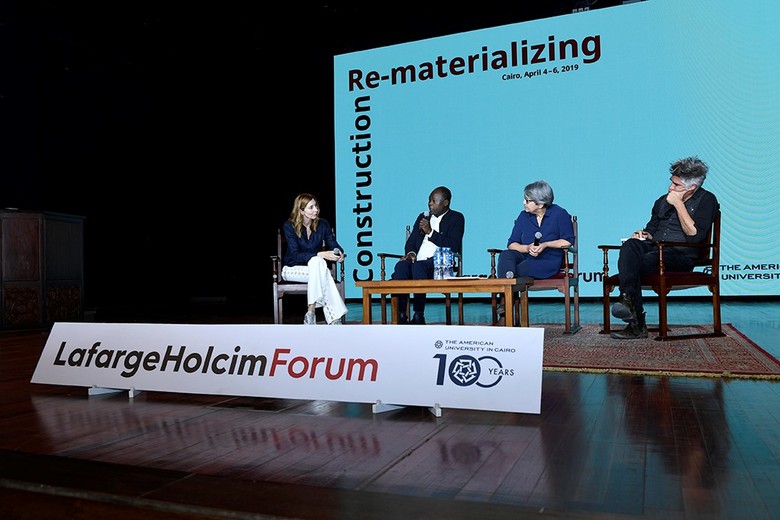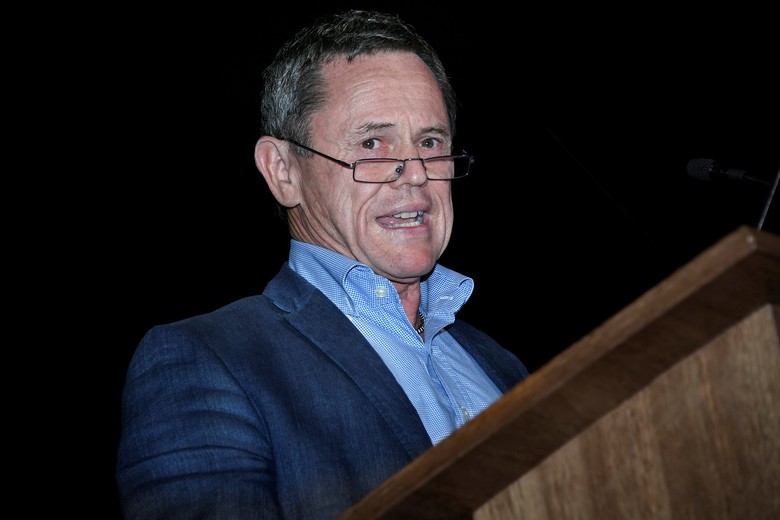For three days during the first week of April, a diverse group of architects, engineers, and building experts converged on Cairo for Re-materializing Construction, the 6th International LafargeHolcim Forum for Sustainable Construction. World-Architects was in attendance and presents here the first of our two-part coverage of the event.
Less concrete, more earthOn the third and final day of the 6th LafargeHolcim Forum, with a few hundred attendees packed into the historic Ewart Memorial Hall at the American University in Cairo (AUC), Austrian architect Anna Heringer — standing at the edge of the stage, her gaze directed at LafargeHolcim CEO Jan Jenisch seated in the front row, and with a noticeable quaver in her voice — said, “LafargeHolcim please, I ask you to raise the price of cement; this overuse of cement is a huge contribution to climate change. As a leader in the field I ask you to make a paradigm change.” Behind her, projected large on the screen, was a photo from one of the Friday rallies where striking students across Europe demand action from those in power to avert climate catastrophe. In it, her daughter holds a handmade sign that reads, “Less concrete, more earth.”
Heringer’s words and the image of her daughter encapsulate the ambitions, ambiguities, and contradictions of the Forum, which took place in Cairo from April 4 to 6 under the theme Re-Materializing Construction: “reducing consumption throughout the material cycle from extraction to processing, transport, installation, maintenance, and removal.” The event, organized by the LafargeHolcim Foundation for Sustainable Construction (an independent legal entity supported by LafargeHolcim, the world’s largest cement supplier and “leading global building materials and solutions company”), brought together more than 350 “leading minds from architecture, engineering, planning, and the building and construction industry … to accelerate their contributions to creating a more sustainable built environment.” This acceleration happened through a handful of keynotes, four concurrent workshops, and four excursions into Cairo, a city of nearly 20 million that accentuates our urgent climate crisis as much as the words of the various Forum participants.
What, in the end, were the conclusions drawn from the various events over the course of the Forum? And how do those conclusions affect, if at all, the actions of architects, builders, and policy makers moving forward?
The Forum took place primarily at AUC, but not the 100-year-old downtown campus that is home to Ewart Memorial Hall and overlooks Tahrir Square, the site and symbol of the Egyptian revolution of 2011. Most of the events were at AUC New Cairo, the 260-acre (105-ha) campus that opened in 2008 about 20 miles (32 km) east of downtown in New Cairo, one of 42 “new cities” built, under construction, or being planned by Egypt’s Ministry of Housing, Utilities & Urban Communities. It was on day one of the Forum at AUC New Cairo — before the opening keynotes by Norman Foster, Herzog & de Meuron’s Christine Binswanger, Lacaton & Vassal’s Anne Lacaton, and Francis Kéré — that Khaled Abbas, Deputy Minister of Housing, presented in-progress images of some of these new desert cities. These included the New Administrative Capital that is being built 43 miles (70 km) east of Cairo and will be home to the glassy Iconic Tower, what will become Egypt’s tallest skyscraper at 385 meters (1,263 feet), and which Alejandro Aravena described about an hour after Abbas’s presentation as “the tallest greenhouse-effect generator in Africa.” With highly questionable architecture and suburban-style urban planning, images of the new cities were shocking, to say the least, and conveyed to Binswanger, on stage with Aravena and Foster, “a lack of education and knowledge” on the part of Egyptian architects and planners. “So it’s good,” she continued, “that this meeting happens here and now.” But her comments were met with groans and silence — no applause — from the packed house of more than 1,200 people, many of them architecture students from AUC that could sit in on this part of the Forum.
Aerial views of the concrete cities rising in the desert near Cairo, including foundation work on Iconic Tower:
The opening keynotes by Foster, Binswanger, Lacaton, and Kéré presented the antithesis of Egypt’s desert cities: bespoke, beautiful buildings made with sensitivity to climate and materials. But they were also extremely expensive (Foster’s $5 billion Apple Park and his £1.3 billion Bloomberg headquarters in London, “the most sustainable building of its kind”), technologically advanced (the prefabricated, machine-made rammed-earth walls of Herzog & de Meuron’s most recent building for Ricola), and highly particular (Lacaton & Vassal’s “make do” transformations of unremarkable public housing projects in Bordeaux, France, into stunning apartments, inside and out); they are hardly models for cities like Cairo. Even Kéré, whose earthen buildings in Burkina Faso are as humble as the architect’s own words, does not supply a ready solution for the billions of people around the world in need of houses, schools, and other necessary structures. Yet as Binswanger remarked when answering a question from Aravena, she would have given a completely different talk if she knew what the Deputy Minister of Housing was going to present; a storehouse for herbal cough drops is insignificant compared to cities for millions rising out of the desert all at once.
Of course, nobody asked the keynote speakers to solve all of the world’s problems or counter the plans of the Ministry of Housing. But Marc Angélil, board member of the LafargeHolcim Foundation and lead moderator over the Forum’s three days, did ask each of them to address one of the 22 Propositions that were developed from roundtable discussions in the years leading up to the Forum. Ranging from “How much does your building weigh, Mr. Foster?” to “If less is more, maybe nothing is everything” (attributed to R. Buckminster Fuller and Rem Koolhaas, respectively), the 22 Propositions served as a framework for Re-materializing Construction. As explained in the booklet given out to Forum attendees, “It is hoped that changes such as [the 22 Propositions] would lead to a construction industry with a smaller ecological footprint and a shift away from the unsustainable assumption that raw materials are infinitely available.” Did Lord Foster tell us how much Apple Park weighs? Well, no, but he did promote his brand of (high-tech and pricey) sustainability. Most successfully, in my opinion, was Lacaton, who may have made 1,200 proponents for her "Never demolish, always transform" proposition, not only through the quality of her firm’s architecture but the fact the renovations never displaced any residents during construction — compassion and understanding are just as important as designing beautiful structures.
Back at the Tahrir Square campus on the afternoon of day three, after Heringer's remarks and her fellow workshop moderators summarized their workshop findings (in between the opening and closing keynotes were the four workshops and excursions that will be the subject of our second article), Simon Upton, New Zealand's Parliamentary Commissioner for the Environment and a four-time Forum participant, summarized the three-day event — more accurately, his experience of it, pointing out that with so many concurrent events it would be impossible for any one person to summarize the whole Forum. After praising the Forum’s thorough and precise organization (I’ll admit the bus and buffet logistics alone were staggering), Upton praised some of the presentations he attended but also lent a sympathetic voice to Egypt’s new cities: “The Deputy Housing Minister, facing runaway population growth, doesn’t have the time available for the costly and disruptive rewiring of our systems and materials.” But, he went on to say, “We also have to accept that the planet won’t give us much time if we don’t.”
Time, or lack thereof, came to the fore throughout the talks, workshops, tours, and informal discussions of the Forum, as did scale and responsibility. There was a sense of urgency that we must act now and at an unprecedented scale to protect the earth, ourselves, and future generations in the face of climate change. With a theme focused squarely on materials, architects obviously have a great responsibility, especially with regard to the materials they choose; or as Upton framed it, moving forward architects “would choose the energy required to produce materials” rather than just the materials themselves. Such decision-making would put responsibility on politicians to enact regulatory laws and companies like LafargeHolcim to produce leaner materials. But the time to enact such laws and realize such scientific breakthroughs are long compared to the do-it-now urgency sensed throughout the Forum. So Upton suggested a three-year extension to the three-day Forum: real-world projects in real-world places — difficult places, he said, not Sweden — that would bring designers, educators, and materials experts together with political leaders, leading to engagements and possible breakthroughs at a scale needed to have an impact.
Can architects, builders, materials suppliers, and others involved in the shaping of the built environment do their part to keep global temperature rise below the 2°C increase set by the Paris Agreement? It is an apparently insurmountable task, especially when confronted by the rampant, business-as-usual urbanization underway in the Egyptian desert and the many other places around the globe faced with booming populations and cities unable to accommodate them. Even with these circumstances, and with the effects of climate change happening more frequently and rapidly than predicted, optimism pervaded the three days of the Forum. While cruising the Nile for the final dinner, an architect at my table mentioned how eager she was to get home and carry this positive energy into her work. But how long can such optimism prevail? To overcome the issues discussed at the Forum, there's only one acceptable answer: forever.
World-Architects travel and accommodations for the LafargeHolcim Forum were made possible by the LafargeHolcim Foundation.



